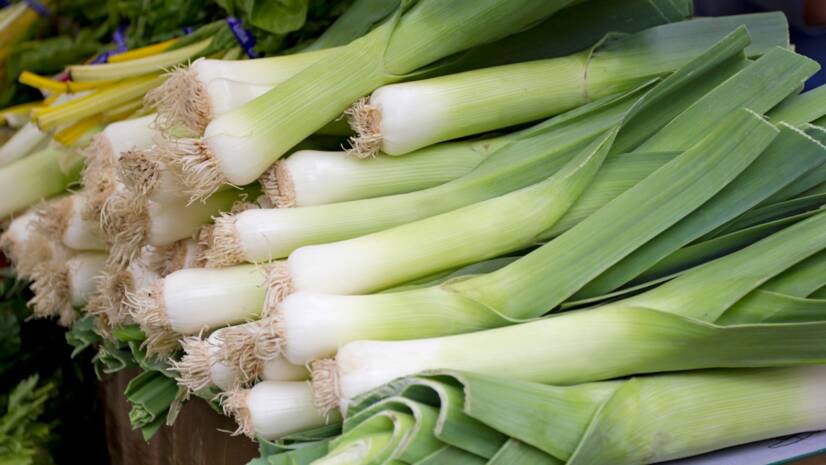Leeks and their health benefits. Do you know how to grow them?

Leeks are easy to grow, but all the more effective for our health.
Characteristics
There are several types of leeks that can be grown. There are summer, winter and wild leeks. In each case, they are similar to onions because they are layered in the same way and taste very similar.
The taste of leeks is sweeter and, above all, they do not smell or burn.
Leeks are cylindrical in shape, so they do not have a round onion with gills. The onion and leaves are fused. Only the colour changes, from the root to white and the leaves are already green. At the same time, the leaves come out of the outer layer of the onion.
Almost all of it is processed, up to two thirds can be used.
It grows to a large size, the leaves reaching up to one metre above the ground. The fruit is again along its surface, as with the onion.
Its health benefits were already discovered by the ancient Romans and Greeks, who used leek decoctions, for example, even for alcohol poisoning.
This miracle vegetable helps to cleanse the body during diets. It has a good effect on digestion and on the heart and blood vessels.
It should be used in salads, sauces and medicinal broths and soups.
Growing leeks
There is a difference in growing summer and winter varieties.
Pre-growing is recommended. Pre-grown leeks should be about the size of a pencil. When they are large enough, cut off the twig and trim the roots. They can then be planted a little deeper.
Summer leeks also differ in appearance from winter leeks. They are much thinner and longer. They are planted at 15 cm apart. Winter leeks should be 25 to 30 cm apart.
It is recommended to sow summer leeks at the end of March/beginning of April and winter leeks in May/June. Summer leeks are also less cold tolerant, which is to be expected from their name.
Growers recommend growing it in soil after potatoes or cucumbers.
The leeks should be covered with soil and the bed should be covered with non-woven fabric. This is important as protection against pests. Alternatively, we can get rid of pests and protect the leeks by spraying them.
The quality of the leeks is also affected by regular watering, which is very necessary, especially at the beginning of the growing season.
Thanks to leeks, our body gains
- vitamins A, B, C, E and K
- potassium, phosphorus, magnesium, manganese, calcium and iron
- folic acid - but only in its raw state
- carotenes, selenium, fibre
Internal use
Leeks can be processed almost whole. Use the white part, but also the green part.
In the kitchen, of course, it is best used raw and cooked.
Especially in its raw state, it has a very beneficial effect on our body. In this case, it is advisable to chop the cleaned and washed leeks, for example, into healthy bread or add them to a delicious spread.
Thanks to its vitamins, it has an effect on immunity and is useful in regulating blood sugar levels.
As part of immunity, it improves resistance to colds, flu and infections.
The combination of vitamins and minerals in leeks is also good for cleansing the intestines of bacteria and yeast. Therefore, it is consumed for bloating, constipation and also helps with intestinal colic.
Folic acid in leeks has an effect on blood cell and muscle formation and better wound healing. Phosphorus in turn helps improve brain function.
Leeks are also an excellent dietary ingredient as they contain minimal fats and sugars.
It is great for fighting off hunger and inducing a feeling of satiety.
The most suitable 'partner' for leeks, especially in diets, is celery. Together they form a powerful duo that supports digestion and cleanses the intestines.
Also, in combination with garlic, they fight cholesterol. People with low blood pressure should be careful, as this duo lowers blood pressure.
Leeks are also not suitable in large quantities for people with kidney and gallbladder disorders, as they contain a number of oxalic acid salts that can put a strain on these organs.
Consumption
As we have already mentioned, it is best eaten raw.
We use the whole leek. However, the green part of the leek is sharper, so it is not for everyone.
It can also be used raw in spreads, as a substitute for onions. For example, it is excellent in egg spreads. Leeks can also be used in cheese or fish spreads.
A very popular recipe is leek soup. It can be prepared in several ways. We know it in variants with vegetable broth or in cream form.
Leeks are also great under meat or in risotto. For kitchen experimenters, there are also recipes for savoury pies.
In home medicine, a strong leek broth is also used without the use of spices. Strain it hot and mix it with honey. Such a medicinal syrup can be used to help with coughs and sore throats.
Harvesting and storage
Leeks should be harvested before the first frosts, but may take several months. They are not a vegetable that needs to be harvested at a specific time.
So we harvest them from the garden when we want them, while the rest will last in the ground.
However, once the leeks have been harvested from the garden, the roots are cut to a maximum length of 2 cm. They are also thoroughly cleaned by hand of soil and any dirt, but never with water.
We also trim the leaves, i.e. the green part where they are no longer attached to the onion, which means that we trim only the green leaves themselves.
Store the leeks in a cool and sufficiently moist cellar. The moisture will ensure longer freshness.
Some gardeners also recommend storing in limed coarse sand. In this case, store the leeks in the sand in a vertical position, with the vegetable buried along the entire length of the stem.










